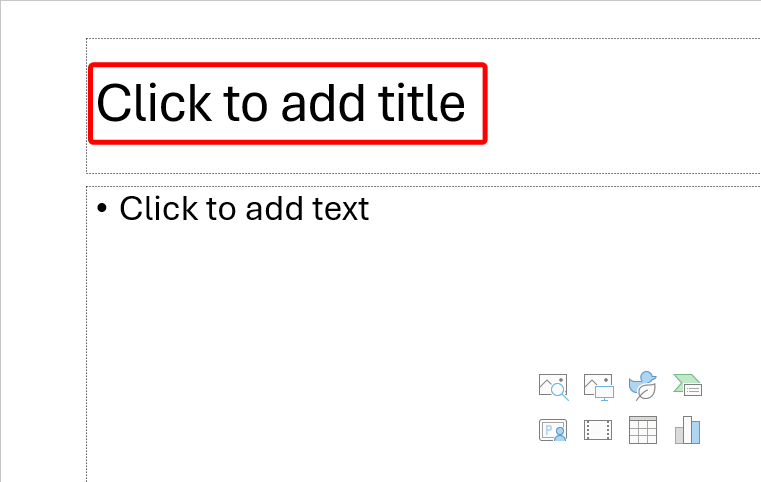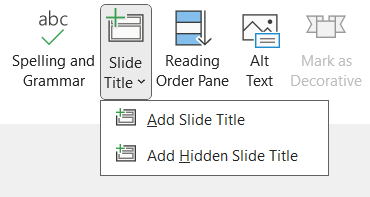PowerPoint Accessibility
Structure of Slides
On this page:
Slide Layouts
Providing structure to documents is essential for assistive technology, but help all readers navigate your documents efficiently and understand relationships between topics.
Slide Titles
Ensure slides have a title placeholder (most default layouts do). Slides must have a “Click to add title” placeholder to create a properly coded title. Manually adding a text box and increasing the font size does not make a proper title. If you find many of your slides do not have title placeholders, review the slide masters and add title placeholders.

Ensure each slide has a descriptive, unique title. Effective titles help orient all users and provides structure to draw connections and enhance understanding. Titles allow all users to efficiently navigate your presentation.
For slides that contain media, such as a full-size image, chart, or other graphic or video, consider “hiding” the slide title.
To hide a slide title:
- Move to the Accessibility tab.
- Open the Slide Title menu and choose Add Hidden Slide Title.

- Or click and drag an existing slide title out of the frame of the slide.
How to title a slide from Microsoft support.
If the information of a slide continues to a second slide, best practice is to name your slides “Example Title 1 of 2” and “Example Title 2 of 2.”
Slide Structure
Using textboxes as titles does not provide structure. Textboxes are read in the order they are added.
To change slide layout:
- Select Home
- Click Layout
- Select appropriate layout and fill placeholders as needed.
- Layouts provide semantic structure and are pre-formatted with proper reading order.
Reading Order
The reading order of slides is essential for screen reader and text to speech users. Ensure reading order matches visual order.
Check the reading order of each slide to ensure it will be read logically by assistive technology.
On Windows:
- Select Review tab > Check Accessibility button > Reading Order Pane
- Drag and drop elements to their proper reading order
- Rearranging items does not change their position on the slide
- Click through list to ensure reading order matches visual layout
Avoid adding textboxes to slides for anything other than plain text. Instead, modify slide layouts and add proper placeholders.
To ensure accessible structure avoid invisible tables, text boxes, and repeated tabs, spaces, or returns. Instead:
- Create columns using Layout > Columns.
- Change spacing before and after paragraphs via Home > Line Spacing Options.
- Manually create a line break by pressing Shift and Enter.
- Of repeatedly pressing Enter, use Insert > Page Break.
- Of repeatedly pressing Tab or Spacebar, navigate to Home > Increase/Decrease Indent or use the indent markers on the horizontal ruler (View > Ruler).
Tables
Tables are useful for organizing data. Properly built and formatted tables are completely accessible.
Table Best Practices
- Tables must have a header and/or column row.
- A concise, descriptive table title helps with context and organization
- Do not use nested, merged, split, or unnecessary blank cells
- Ensure cells have adequate padding and margins
- Do not use coloured cells or text alone to indicate meaning
- Do not use tables with invisible borders to format layout
- Office accessibility checker does not note table errors
- Click in the top left cell, then use the Tab key to see ensure your table reading order is logical and consistent
To insert a table in PowerPoint:
- Insert tab
- Table
- Insert Table
- Indicate number of columns and rows and press Ok
- You can add columns and rows later
Set a header row/column:
- Click anywhere in your table.
- Select Table > Table Design tab > click Header Row (or First Column, if column is a header) checkbox.
- Select Banded Rows or Banded Columns for a landscape document.
- Select the header row then navigate to Table Layout, select Repeat Header Rows to repeat headers across page breaks.
- Accessible tables in Word can only have one header row, one header column, or both.
Right-click on table and select Table Properties for advanced table options via the table properties dialogue.
In some instances it may make sense to add alt text to a table as a summary. To do so:
- Navigate to Table Properties
- Select the Alt Text tab
- Add a Title and a Description
- Click Ok
Lists
Properly formatted lists organize information and makes your presentations accessible.
- Use bullet lists for unorganized lists
- Lists where the sequence is not important
- Use numbered lists for items where sequence is important
- Such as steps in a process
To create a list in PowerPoint:
- On the Home tab
- Select Bullets, Numbering, or Multilevel List
- The dropdowns accompanying each style offer more options and customization.
Lists can be converted to SmartArt. There are some additional steps to make SmartArt accessible.
The use of code (HTML attributes, PDF tags, XML, etc.) to distinguish content by meaning, not appearance. For example, a <h1> heading tag creates both a visual and coded navigation waypoint whereas increasing the font size and bolding simply makes regular text appear larger.
Information presented in a grid format of rows and columns, generally to show a relationship between sets of data

